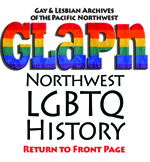Oregon Anti-Gay Ballot Measures
(Click here to download this article as a PDF file.)
By George T. Nicola
April 10, 2013
Oregon was once admired for its direct democracy processes. This has included the initiative, referendum, and recall, all of which are part what has been heralded as the “Oregon System.” These reforms have generally been beneficial but have on occasion had an unpleasant side -- they have sometimes been used by the majority to limit the rights of minorities.
We have witnessed this numerous times in Oregon, and the victims have generally been gay men and lesbians. The problem has been exacerbated by the fact that only a simple majority vote, 50% plus 1, is needed to amend the state constitution.
Oregon has had about 35 anti-gay ballot measures, probably more than any other state in the country. None of these measures dealt with transgender rights, but probably would have been interpreted to include them. Only one measure mentioned bisexuality specifically, but most would have affected bisexuals by preventing protection from discrimination based on sexual orientation.
This document is not intended to be a source of legal advice or analysis. If you have a question about legal rights, please contact a legal professional. If you believe you are the victim of discrimination based on your sexual orientation or your gender identity, please contact the Oregon Bureau of Labor’s Civil Rights Division through http://www.oregon.gov/boli/CRD/Pages/C_Crcompl.aspx.
If you discover any inaccuracies in this article, or if you suggest any additions, please contact GLAPN at info@glapn.org and we will review your input.
1978: City of Eugene Measure 51
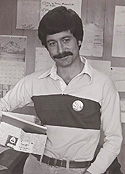 In the 1970s, the City of Eugene had an ordinance that banned discrimination based on a number of criteria. Eugene’s gay community worked for many years to get sexual orientation added. They finally succeeded in 1977. The Oregonian newspaper reported that the “measure prohibited discrimination on the basis of sexual orientation in the areas of employment, housing and public accommodations within the city.”
In the 1970s, the City of Eugene had an ordinance that banned discrimination based on a number of criteria. Eugene’s gay community worked for many years to get sexual orientation added. They finally succeeded in 1977. The Oregonian newspaper reported that the “measure prohibited discrimination on the basis of sexual orientation in the areas of employment, housing and public accommodations within the city.”
Terry Bean was a Eugene gay activist who worked to defeat Measure 51. He later moved to Portland and became involved in the statewide LGBT movement. On a national level, he was cofounder of the Human Rights Campaign and the Gay and Lesbian Victory Fund.
The following year, a group called VOICE (Volunteers Organizing and Involved in Community Enactment) collected signatures and managed to get a referendum on the ballot to repeal the ordinance.
About 64% favored Measure 51, winning by a 29% margin, so the civil rights protection given to gays was repealed.
About two decades later, the City of Eugene again passed an ordinance that banned discrimination based on sexual orientation. This time, the law was not challenged and remained on the books.
1988: State of Oregon Measure 8
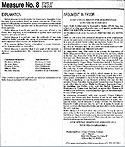 In 1987, Oregon Governor Neil Goldschmidt issued an executive order which banned discrimination based on sexual orientation in the executive department of state government. The Oregonian described the order as “dealing with sexual orientation and the state government workplace.” The newspaper elaborated that “This included both personnel actions and the delivery of services to the public. The order didn't apply to state employees not under Goldschmidt’s control, such as judicial workers.”
In 1987, Oregon Governor Neil Goldschmidt issued an executive order which banned discrimination based on sexual orientation in the executive department of state government. The Oregonian described the order as “dealing with sexual orientation and the state government workplace.” The newspaper elaborated that “This included both personnel actions and the delivery of services to the public. The order didn't apply to state employees not under Goldschmidt’s control, such as judicial workers.”
Unfortunately, the order was overturned by an initiative called Ballot Measure 8. Measure 8, sponsored by a group called the Oregon Citizens Alliance (OCA), also prohibited any state official in the future from requiring non-discrimination against state employees based on sexual orientation. This initiative won by a 5.4% margin.
 Harriet P. Merrick, a lesbian employee of the University of Oregon, took the new law to court in cooperation with the American Civil Liberties Union of Oregon. In Merrick v. Oregon, 1992, the Oregon Court of Appeals ruled Measure 8 unconstitutional because its effect was “to restrain the right of free expression.”
Harriet P. Merrick, a lesbian employee of the University of Oregon, took the new law to court in cooperation with the American Civil Liberties Union of Oregon. In Merrick v. Oregon, 1992, the Oregon Court of Appeals ruled Measure 8 unconstitutional because its effect was “to restrain the right of free expression.”
Harriet Merrick (right), plaintiff in the law suit that overturned Measure 8.
1992: State of Oregon Measure 9
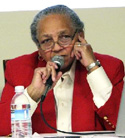 After their initial Measure 8 success, the Oregon Citizens Alliance (OCA) went on to sponsor Ballot Measure 9 in 1992. The measure was titled “Government Cannot Facilitate, Must Discourage Homosexuality, Other Behaviors."
After their initial Measure 8 success, the Oregon Citizens Alliance (OCA) went on to sponsor Ballot Measure 9 in 1992. The measure was titled “Government Cannot Facilitate, Must Discourage Homosexuality, Other Behaviors."
Lesbian activist Kathleen Saadat campaigned tirelessly against Ballot Measure 9.
Click on the image at right to open a readable version of the Measure 9 explanation from the 1992 Oregon Voters' Pamphlet.
Measure 9 would have amended the Oregon constitution to ban civil rights protection based on sexual orientation. It mandated that schools “shall assist in setting a standard for Oregon's youth that recognizes homosexuality, pedophilia, sadism and masochism as abnormal, wrong, unnatural, and perverse and that these behaviors are to be discouraged and avoided.” A section of the measure stating the government could not “promote, encourage, or facilitate homosexuality” could have had many negative results, such as banning gay positive books from public libraries.
Opposition to the measure was bipartisan and included people of many faiths, identities, and ethnicities. Gay men and lesbians came out to people they knew. Straight people increasingly realized that we are their friends, their family, their neighbors, their coworkers. Oregonians began to understand that when gay people as a group are being threatened, someone they love is probably being threatened.
Voters defeated Measure 9 by an impressive 12.9% margin.
1992 to 1994: Local measures similar to Measure 9
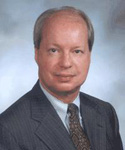 Both before and after the statewide Measure 9, the Oregon Citizens Alliance also took local action. Initiatives similar to Measure 9 were placed on the ballots of about 29 Oregon cities and counties. However, it is difficult to arrive at exact details because there is no one primary online source to research local elections. The vast majority of measures passed, some by huge margins.
Both before and after the statewide Measure 9, the Oregon Citizens Alliance also took local action. Initiatives similar to Measure 9 were placed on the ballots of about 29 Oregon cities and counties. However, it is difficult to arrive at exact details because there is no one primary online source to research local elections. The vast majority of measures passed, some by huge margins.
Pioneering gay attorney Charlie Hinkle worked to defeat many of Oregon's anti-gay ballot measures.
These local initiative all appear to be similar to each other. Like the statewide measure, they forbade civil rights protection based on sexual orientation and prohibited public money from being spent to “promote” homosexuality. However, they apparently differed from the statewide initiative in that the local measures did not require an anti-gay curriculum in the schools.
In 1993, the Oregon Legislature invalidated these local measures with House Bill 3500, which prohibits local measures that “single out citizens or groups of citizens on account of sexual orientation.” The law was upheld by the Oregon Supreme Court in 1995.
1994: State of Oregon Measure 13
 The OCA went on to sponsor more statewide initiatives. In 1994, Ballot Measure 13 was titled: “Amends Constitution: Governments Cannot Approve, Create Classifications Based on, Homosexuality.” This measure failed by a 3.1% margin.
The OCA went on to sponsor more statewide initiatives. In 1994, Ballot Measure 13 was titled: “Amends Constitution: Governments Cannot Approve, Create Classifications Based on, Homosexuality.” This measure failed by a 3.1% margin.
Lesbian activist Cathy Abbruzzese worked to defeat Measure 13.
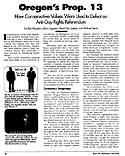 Here is what the ACLU had to say about this initiative:
Here is what the ACLU had to say about this initiative:
The OCA has tried to sell this effort as a "kinder and gentler" version of Measure 9, but they have been quick to admit to their supporters and, on occasion, even the news media, that the effect of this measure would be virtually identical to Measure 9. We agree. The effects of both measures are the same: discrimination, censorship and government intervention in our families, schools, workplaces and daily lives. That's why Measure 13 is the "Son of 9.“
2000: State of Oregon Measure 9
In 2000, the OCA sponsored its last statewide anti-gay initiative which was also named Measure 9: “Prohibits Public School Instruction Encouraging, Promoting, Sanctioning Homosexual, Bisexual Behaviors.”
Lesbian activist Kathleen Sullivan headed the campaign against the OCA’s final anti-gay ballot measure in 2000.
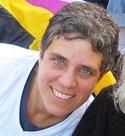 The Oregon Parent Teachers Association submitted an opposition statement in the Voters’ Pamphlet clarifying that “There is NO curriculum in Oregon public schools that ‘encourages or promotes’ homosexuality or bisexuality.” The statement warned that “this measure endangers the health of our children and the quality of our schools.” It also cautioned that the measure would cut:
The Oregon Parent Teachers Association submitted an opposition statement in the Voters’ Pamphlet clarifying that “There is NO curriculum in Oregon public schools that ‘encourages or promotes’ homosexuality or bisexuality.” The statement warned that “this measure endangers the health of our children and the quality of our schools.” It also cautioned that the measure would cut:
- “Access to all health education related to sexuality including abstinence, birth control, sexually transmitted diseases, and HIV/AIDS. It would deny all students information they need to make responsible, healthy choices.”
- “Counseling or support programs for all adolescent students, making it even more difficult for teenagers to come to terms with their sexuality or for counselors to give teenagers information about support groups.”
- State funding “because of what one person might say. We can't let the agenda of one extremist organization endanger the health of our children and the quality of their schools.”
This initiative lost by a 5.7% margin.
2004: State of Oregon Measure 36
The final anti-gay initiative to date, Measure 36, was sponsored by a group called the Defense of Marriage Coalition. Its purpose was to ban same -gender marriage in Oregon by amending the state’s constitution.
The ballot title read “AMENDS CONSTITUTION: ONLY MARRIAGE BETWEEN ONE MAN AND ONE WOMAN IS VALID OR LEGALLY RECOGNIZED AS MARRIAGE.” The actual amendment text was “It is the policy of Oregon, and its political subdivisions, that only a marriage between one man and one woman shall be valid or legally recognized as a marriage.” The Measure passed by a 13% margin.
When it was challenged through a law suit, Martinez v. Kulongoski, the measure was affirmed by the Oregon Court of Appeals. The decision was appealed to the Oregon Supreme Court, but the high court denied the petition to hear the case.
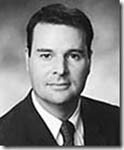 Right: Judge Michael McShane
Right: Judge Michael McShane
In late 2013, two federal lawsuits -- Geiger v. Kitzhaber and Rummell v. Kitzhaber – were filed challenging the ban. The two cases were consolidated by U.S. District Court Judge Michael McShane, who issued his decision on May 19, 2014. McShane ruled that Oregon’s laws banning same-gender marriage “violate the Equal Protection Clause of the Fourteenth Amendment to the United States Constitution.” Same-gender weddings started the same day.
P.O. Box 3646 • Portland, OR 97208-3646 • info@glapn.or
Copyright © 2014
